In the Moment:
Michael Frye's Landscape Photography Blog
by Michael Frye | Sep 7, 2014 | Night Photography
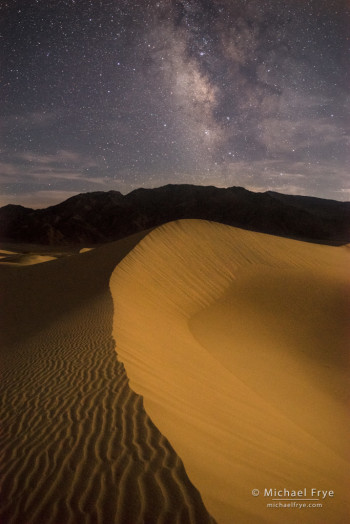
Moonlit sand dunes and the Milky Way, Death Valley. This is the photograph I originally envisioned from Death Valley, with dunes lit by the setting moon and the Milky Way above. (20 sec. at f/2.8, 6400 ISO)
Where do you go to escape the crowds on Labor Day weekend? How about Death Valley, where the temperature was forecast to be 112 degrees! That should keep the tourists away.
Okay, escaping the crowds wasn’t really the motivation for going to Death Valley in August. I had an idea for making a photograph with low-angle moonlight illuminating the sand dunes, and the Milky Way above. The moon had to be in the right phase: too much moonlight and the sky would become washed out, obscuring the Milky Way and most of the stars; too little and you wouldn’t see the effect of the moonlight on the dunes.
The moon also had to be far enough from the Milky Way to keep the moon itself out of the photograph, as it would be impossible to properly expose both the moon and the landscape in the same frame. The moon also needed to be close to the horizon, and off to the side (with the camera pointed at the Milky Way), as that low-angle sidelight would emphasize the form and texture of the dunes.
Not long ago I wrote about two apps for forecasting the position of the Milky Way and moon, PhotoPills and Star Walk. Consulting both of these apps I had figured out that the moon and Milky Way would be in the right position for the photograph I had in mind on the Friday and Saturday before Labor Day. And the next time the moon and Milky Way would be in a good position for this would be… next April, or even May. I decided to brave the heat rather than wait.
I had initially planned to go to Death Valley on Friday, but a thick bank of high clouds moved in – the remnants of Tropical Storm Marie. Since the skies looked clearer further south, Claudia and I kept driving and headed for the Trona Pinnacles.
(more…)
by Michael Frye | Sep 4, 2014 | Announcements
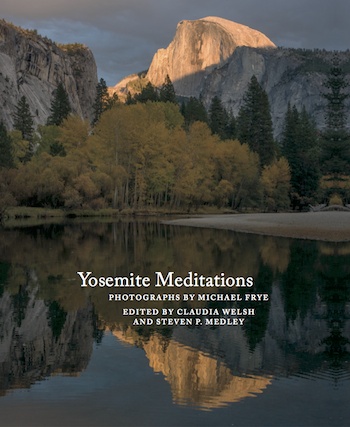 In the early 2000s, my wife Claudia – then manager of The Ansel Adams Gallery – saw the need for small, inspirational books for the Yosemite visitor. She worked with Steve Medley, the president, publisher, and editor for the Yosemite Association (now Yosemite Conservancy), to find meaningful quotes about nature, conservation, and Yosemite, and pair those quotes with my photographs to create the original Yosemite Meditations book. Since then, Yosemite Meditations has gone through several reprints, and spawned two companion volumes: Yosemite Meditations for Women, and Yosemite Meditations for Adventurers.
In the early 2000s, my wife Claudia – then manager of The Ansel Adams Gallery – saw the need for small, inspirational books for the Yosemite visitor. She worked with Steve Medley, the president, publisher, and editor for the Yosemite Association (now Yosemite Conservancy), to find meaningful quotes about nature, conservation, and Yosemite, and pair those quotes with my photographs to create the original Yosemite Meditations book. Since then, Yosemite Meditations has gone through several reprints, and spawned two companion volumes: Yosemite Meditations for Women, and Yosemite Meditations for Adventurers.
Now the Yosemite Conservancy has released the Tenth Anniversary Edition of Yosemite Meditations. Again, Claudia did a great job of finding and pairing new quotes and photographs, mixing them with favorites from the first edition, and keeping the spirit and flavor of the original book.
If you order the Tenth Anniversary Edition of Yosemite Meditations directly from us through the “Add to Cart” button below, Claudia and I will both sign the book. You can also order directly from the publisher, the non-profit Yosemite Conservancy. In addition, the Conservancy has a 10% discount on Yosemite Meditations for Adventurers as their Retail Item of the Month (enter the code ADVENTURE on checkout).
There’s a nice review of the new edition of Yosemite Meditations on VividLife. Also, if you’re on Goodreads, we’re giving away (through the generosity of the Yosemite Conservancy) ten copies of this tenth anniversary edition.
(more…)
by Michael Frye | Sep 2, 2014 | Night Photography
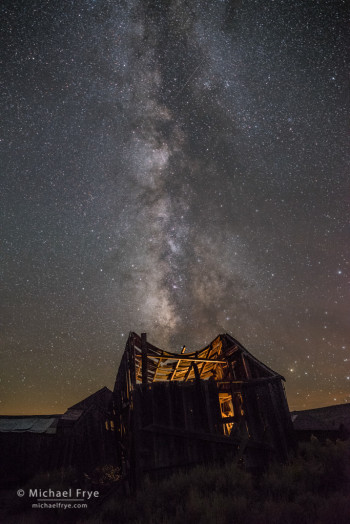
“Swayback” building at night with the Milky Way, Bodie. While helping some members of our group photograph this building I set up my own camera as well. I put tissue paper over a flashlight to act as a diffuser, then stuck my hand through a gap in one of the walls to light the interior of the building during the 20-second exposure for the stars.
As promised, here are some of my recent photographs from Bodie. Bodie, if you’re not familiar with it, is just north of Mono Lake, and is billed as the best-preserved ghost town in the United States. Bodie is now a state park, and a very interesting place to photograph, but it’s usually only open from 9:00 a.m. to 6:00 p.m., which means you can’t photograph it during the best light of the day, much less at night.
A few years ago I was able to photograph Bodie on a moonlit night with Lance Keimig and Scott Martin during one of their workshops. Then, earlier this summer, Claudia and I went to Bodie on one of occasional evenings when the park stays open until 10:00 p.m. This was a moonless night, but since it didn’t get completely dark until about 9:00 p.m. that left only an hour for true night photography. It was still fun, but much too short.
Luckily I would have another chance soon. We had managed to secure a hard-to-get permit to take a workshop group there at night, and added that evening to my Starry Skies Adventure workshop. We had so much fun there with the group. This time we were able to stay until 1:00 a.m., but it wasn’t long enough!
Here’s a selection of both daytime and nighttime images from those recent trips to Bodie. I tried many different ideas, but had to leave other ideas still percolating in the back of my mind, as I just didn’t have time to execute them all. I think there’s so much potential there for creative lighting of both interiors and exteriors, and working with reflections in the old windows. I certainly look forward to going back. If you haven’t been to Bodie, I highly recommend it, even during the middle of the day. And if you get a chance to go in the late afternoon or at night, take it!
— Michael Frye
(more…)
by Michael Frye | Aug 28, 2014 | Night Photography
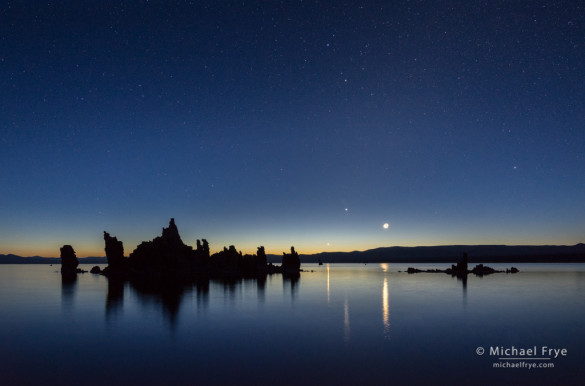
Venus, Jupiter, and the Moon rising at dawn, Mono Lake, Saturday morning
We had a wonderful time during our Starry Skies Adventure workshop last week. We managed to dodge the fires and had four clear, smoke-free nights. It was a really nice group, and photographing under a sky full of stars is always such a great experience.
One of the highlights of the workshop was viewing and photographing a dawn alignment of Venus, Jupiter, and the Moon over Mono Lake last Saturday. It’s hard to convey how gorgeous this was in a photograph, but you’ll find my best attempt above.
We also photographed star trails and the Milky Way, and went to Bodie on our last night. I’ll save the Bodie images for a later post, but you’ll find a selection of other images from the workshop below.
(more…)
by Michael Frye | Aug 14, 2014 | Night Photography
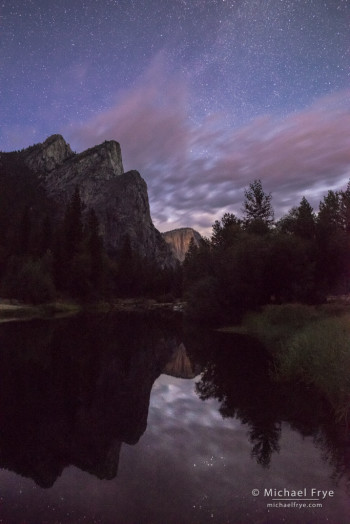
Stars and clouds over Three Brothers, Tuesday evening; 20 seconds, f/2.8, 6400 ISO
Tuesday evening Claudia and I drove to Yosemite Valley. The moon was due to rise about 90 minutes after sunset, so I hoped to photograph the northern end of the Milky Way over Three Brothers, with the rising moon adding a bit of light to the peaks.
We got to the Valley well before sunset, but there were some interesting clouds, so we decided to head to Tunnel View, where we found the usual August assortment of tour buses and people taking selfies in front of the panorama. I photographed some interesting patterns of dappled sunlight and clouds, then, just at sunset, after the crowds had thinned, the sky turned pink and a beautiful array of tufted clouds drifted overhead (below).
We had a little picnic along the Merced River as we waited for the sky to get dark, then I started taking photos of Three Brothers. At first the clouds blocked most of the stars. But the sky gradually cleared, revealing more stars, and then, looking at the photos on my camera’s LCD screen, I could see the clouds taking on a pink hue, and a hint of light on Yosemite Point in the distance. This was the lunar equivalent of a predawn glow, with the moon still below the horizon, but already adding some light and color to the scene. My eyes couldn’t see the color, but the camera could (right).
Later, as the moon rose for real, the clouds and peaks turned gold, just as they would at sunrise. Again, it was too dark for the cones in my retinas to pick up the color, but the camera recorded it perfectly. And some of the cloud formations were spectacular, fanning out in big V shapes above Three Brothers (below).
(more…)
by Michael Frye | Aug 14, 2014 | Travels and Stories
You don’t always get what you hope for, or what you expect, but that’s okay.
On Saturday, Claudia and I wanted to find a place to view the moonrise, but it’s the wrong time of year to see a full moon rising next to Half Dome, or any of Yosemite Valley’s more interesting rock formations. So we decided to climb Mt. Hoffman, which has a panoramic, 360 degree view from the geographical center of the park. From there the moon would rise over the high peaks near Mt. Lyell in the park’s southeastern corner.
There were lots of clouds that afternoon, so we didn’t know whether we’d see the moon at all, but reasoned that the clouds could create a nice sunset, moon or not. And then there was still a little smoke emanating from the Dark Hole Fire along Yosemite Creek, which might block the light. But you never know until you try, so we started up.
We had both climbed Mt. Hoffman before, but it had been a long time. The peak is pretty close to the road, so the climb to its summit is “only” four miles. It’s a steep ascent though, with an elevation gain of about 2,000 feet, at high altitude, so we definitely felt the climb in our legs and lungs.
Along the way there were great views of the Cathedral Range to the southeast, giving us an excuse to stop and rest. During those breaks we could see some very dark clouds to the east, and occasionally hear a rumble of thunder, so we paid close attention to the weather in case some of that rain and thunder might move in our direction. Luckily the stormy weather stayed to the east.
At one point the sun broke through the clouds and created some dramatic light on Cathedral Peak, so I got out my camera and made a few quick exposures (you can see one below).
Mt. Hoffman actually has several summits. We decided to go to the highest point first (the one with the radio tower), where we met and chatted with a couple of other hikers. As the sun lowered, and light started to get more interesting, I moved down the ridge to line up distant Mt. Conness with some of the cliffs along Mt. Hoffman’s summit ridge.
And then I saw a rainbow in the distance, over Tuolumne Meadows, but the rainbow was blocked by the foreground ridges. I had a choice: go back up to the summit, or down and along the ridge to another viewpoint. I decided going down was quicker, but by the time I got to a viewpoint the rainbow had faded. Oh well.
by Michael Frye | Aug 6, 2014 | Composition, Vision and Creativity
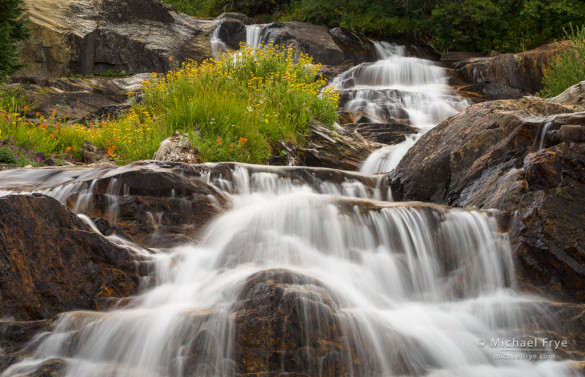
Wildflower island and cascade, eastern Sierra; 100mm, 1/2 sec. at f/16, 100 ISO
It’s been an interesting summer in the Sierra. Last winter was one of the driest on record, but over the last month or so we’ve seen a steady flow of monsoonal moisture flowing up from the southeast, leading to frequent afternoon showers and thunderstorms over the higher elevations. We even heard about an epic deluge two or three weeks ago that flooded the parking lot and some of the tent cabins at the Tuolumne Meadows Lodge.
That extra moisture has kept the streams flowing and flowers blooming in the high country longer than I would have expected. On Saturday Claudia and I hiked up one of the eastern Sierra canyons and found a pretty series of cascades, with an island of late-summer flowers in the middle.
Although I make my share of black-and-white photographs, I’ve always been attracted to color. I often look for color, then try to build a composition around it. As I tell my workshop students, color isn’t enough – you need to find a design to go with that color.
In this case, that design proved to be elusive. The most obvious composition was a wide-angle view with a patch of flowers at the bottom, and the upper cascade above. But there was a distracting pile of logs at the base of the cascade that cluttered the image, with no obvious way to eliminate or minimize the logs. I have nothing against logs, but in this case I was interested in the flowers and water, and the logs broke up the visual flow between the flowers and water, diluting the photograph’s message:
(more…)
by Michael Frye | Jul 30, 2014 | Vision and Creativity
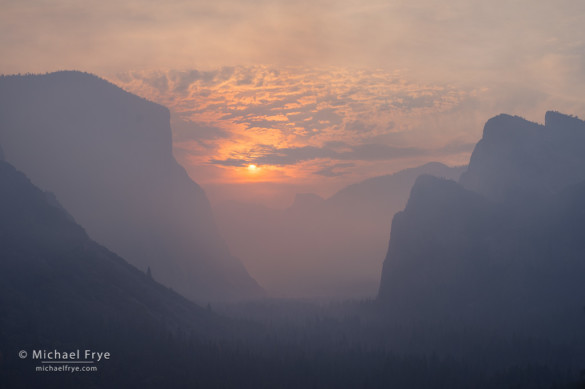
Sun rising through smoke from Tunnel View, 7/28/14, Yosemite NP, CA, USA
Early Monday morning I drove up to Yosemite Valley, hoping that smoke from the El Portal and Dark Hole fires might create some interesting atmospheric effects. Yes, I went looking for smoke, something that photographers usually avoid. But smoke can impart a wonderful, ethereal quality to photographs – like fog, but with more color.
At Tunnel View the smoke was thick enough to give the scene a misty, painterly look, but not so thick that you couldn’t see anything. Eventually the orange ball of the sun appeared through the smoke, accompanied by a patterned cloud formation (above). Later, along the Merced River, the smoke lent a similar painterly mood to scenes of El Capitan and Three Brothers (below). And much later, near sunset, the sun turned into an orange ball again as it sunk into the smoke to the west (below).
(more…)
by Michael Frye | Jul 27, 2014 | Announcements
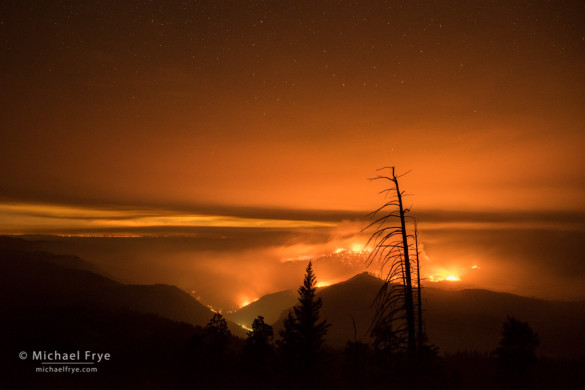
El Portal Fire from the Glacier Point Road; 1:51 a.m., 7/27/14
We had no inkling that anything was wrong until we reached Crane Flat, where a ranger told us the road down to Yosemite Valley was closed.
Claudia had said that the wildflowers were nice in the Yosemite high country, so we decided to go for a hike up there yesterday afternoon. We drove through El Portal sometime between 3:00 and 3:30 p.m. and continued up the Big Oak Flat Road to Crane Flat. Everything seemed normal. Near Yosemite Creek we passed the Dark Hole Fire. This is a lightning-caused fire that the park service is letting burn, but it looked pretty active yesterday afternoon, with a big smoke plume.
We continued on past Tuolumne Meadows, started our hike, and found some gorgeous wildflowers (you can see a photograph below). Then we returned to the car, and started home at about 10 p.m. Near Yosemite Creek I decided to stop and photograph the Dark Hole Fire (below), then we continued west back to Crane Flat, where we saw a ranger vehicle blocking the road down to Yosemite Valley.
We were surprised that the road was closed, since we’d just driven up it a few hours earlier. The ranger let us through, since we had a park sticker, but he told us there was no stopping, and to watch out for fire crews. Fire crews? We knew these crews weren’t for the Dark Hole Fire, as that was miles away, and still pretty small. What had happened?
(more…)
by Michael Frye | Jul 17, 2014 | Photography Tips
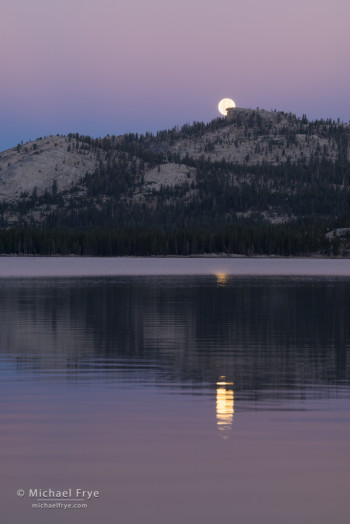
Moon setting over Tenaya Lake, Saturday morning, 5:42 a.m.
“I have always been mindful of Edward Weston’s remark, ‘If I wait for something here I may lose something better over there.’ I have found that keeping on the move is generally more rewarding.”
— Ansel Adams
Sooner or later, every landscape photographer has to decide whether to stay put and hope that the light gets better, or move somewhere else.
Last Saturday morning, on the last day of my Hidden Yosemite workshop with The Ansel Adams Gallery, we rose early and drove to Tenaya Lake to capture the moon setting over the water. On our way there we noticed low-lying mist in Tuolumne Meadows. We photographed a beautiful moonset over the lake, but as soon as the moon dropped below the ridge we drove back to Tuolumne.
The mist was still there. First we ran out to a small pond to catch the sun lighting some small clouds above the high peaks to the east. Then we spotted a herd of deer off to the left in the mist, so we quickly changed lenses and photographed them until they moved away.
By then the sun was hitting Unicorn Peak, so we walked about a hundred feet north to get a reflection of the peak in the pond, and waited until the sun grazed across the foreground.
Then light started hitting the mist and trees behind us, so we moved again to get closer, and put the sun behind trees where we could see sunbeams and starbursts.
And then the sun rose higher, the mist disappeared, and the show was over. The whole sequence lasted about 40 minutes.
In this case, the light and fog were changing quickly, so we had to switch lenses and move our feet if we wanted to catch those fleeting moments. But three years ago, during the same workshop, a similar situation required waiting patiently for the light to change.
(more…)

















